All prices in Canadian dollars as per BC Liquor Stores, unless otherwise noted.
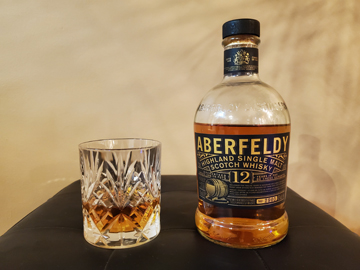
Origin: Aberfeldy, Scotland (Highland)
Type: single malt scotch
Alcohol Content: 40%
Aged: 12 years
Notes: matured in oak casks
Price: 60 / 750 mL
Review Date: 2020-04-28
I suggest to read the chronologically first 16 year review first, because this will be a short one.
Everything is very similar to the 16 year Aberfeldy, but the extra years in sherry casks make for lots of smoothness and really impart extra layers to everything. This is a nice drink, but it's missing that special something, and the difference in years (and price) stands out starkly when tasted back to back.
Verdict: straight-forward and easy to drink, this is a good all-around scotch, and a solid Highlands entry.
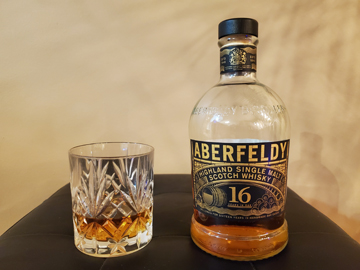
Origin: Aberfeldy, Scotland (Highland)
Type: single malt scotch
Alcohol Content: 40%
Aged: 16 years
Notes: matured in oak, finished in sherry casks
Price: 95 / 750 mL
Review Date: 2020-04-12
This is the first Highlands scotch I am reviewing, although it is not the first one I have had, Dalmore being the most notable and famous one. The Highland region is the northern portion of Scotland centre-mass, and Aberfeldy is smack in the middle of the whole thing. The water source for the distillery is said to run through gold-bearing rocks, thus producing, literally, liquid gold, reflected in the gold print label.
Middle of the road when it comes to color, not too dark, not too pale, but distinctive on everything else. Hits the nose almost like a cider, floral and honeyed, strong, with not much else to it except hints of oak. Not sharp at all, at only 40% alcohol, promising to be smooth and mellow. The taste is very fruity and creamy, almost syrupy, honey coming on strong again with orange peel finish. The citrus and sweetness carries on for a while, something I enjoy quite a bit about this scotch.
Verdict: a fantastic sipper at 40%, this might become a regular on my shelf. I am also looking forward to tasting the more affordable 12 year.
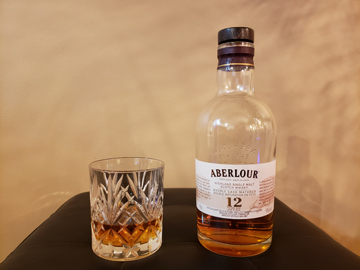
Origin: Aberlour, Scotland (Speyside)
Type: single malt scotch
Alcohol Content: 40%
Aged: 12 years
Notes: matured in oak and sherry casks
Price: 67 / 750 mL
Review Date: 2019-11-20
Distilled and bottled in the less glamorous, but highly prolific, Speyside region of Scotland, this 12 year spirit is captured in a hefty bottle with the thickest of thick necks plugged up with a massive stopper topped with real wood. It certainly feels premium, and comes in at a relatively affordable price, giving good value.
Like all "double cask/oaked/wood" whiskeys, this one packs lots of flavor and depth to enjoy. The enjoyment begins before the first sip, as you will inhale an entire bouquet of scents. I don't feel particularly comfortable using the b-word without sounding pretentious, but it is quite applicable in this case. Depending on occasion, I noticed relatively clean smell with hints of apple cider, ranging all the way to almost riesling- or gewurtz-like citrus fruit intensity.
The rich golden hue says you're in for a full tasting of oak with plenty of roasted caramel sweetness, and it doesn't lie. It feels very full and thick, and finishes round and buttery. By "round" I mean the alcoholic sharpness is not just nearly entirely absent, but it's downright replaced with the opposite characteristic, as if the vapors had a weight of their own. This scotch goes down very smooth and evaporates off the tongue leaving a somewhat sweet buttery feeling and a butterscotch taste that lasts easily between sips. It is not peated, and doesn't carry even a hint of smoke.
Verdict: a good, rich sipper, without the heavy alcohol hit.
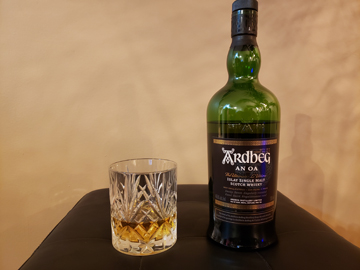
Origin: Ardbeg, Scotland (Islay)
Type: single malt scotch
Alcohol Content: 46.6%
Notes: matured in variety of casks
Price: 105 / 750 mL
Review Date: 2019-12-02
Hailing from the famed Isle of Islay, just down the street from Laphroaig and Lagavulin, so it finds itself in great company, and sets some expectations. Expectations that it does meet. This particular brand has been simultaneously taunting and scaring me off, on account of the fancy presentation and higher sticker price across its modest range, but I did finally pick up this bottle, and I was most impressed.
This scotch comes in a green bottle, as do some other Islay whiskeys, with a distinctive flared bottom and neck. It seems the more smoky scotches are lighter colored, and so is this one, presenting a light gold tone. The scent is very smoky, but rounded and sweet, not sharp or harsh at all, slightly briny as in salted caramel, and a little bit herbal, something like anise or liquorish. Intriguing and inviting.
The taste is as interesting as the scent. Heavy smoke at the beginning, anise and pepper take over, with hints of cloves and maybe tea, if you can imagine eating black tea leaves would taste the same as they smell. The drink is incredibly smooth, leaving behind a pleasant smokiness and some pepper, with anise still trying to poke through. The peat smoking process always introduces some oiliness, and there is definitely a slightly full feeling on the tongue.
Verdict: this is my favorite peated scotch, to date, very mild and tasty, easy to drink despite the higher than average alcohol content.

Origin: Dufftown, Scotland (Speyside)
Type: single malt scotch
Alcohol Content: 43%
Aged: 14 years
Notes: finished in rum casks
Price: 125 / 750 mL
Review Date: 2019-12-15
The Balvenie is located just a stone's throw away north from the Glenfiddich distillery, one of the top scotch producers hailing from the Speyside region. The bottle is classic scotch shape, it has a nice wood top and a topical label to go with the rum theme, as befitting this more upscale and higher priced brand. While fancy with the wood, the stopper is almost comically undersized relative to the neck flare, making it needlessly awkward to open. Matured in the usual American whiskey casks, it is then finished in Balvenie's own rum casks to impart additional depth and flavors (and price).
The perfectly colored liquor hits the nose sophisticated and clean, with no hint of peat or smoke, very fruity, sweet and creamy. But unlike most whiskeys, it doesn't have a very strong taste at all, it's rounded and buttery, with honey, peaches and light caramel sweetness. A warming alcohol presence is there from beginning to end, lingering and definitely heavier than the 43% alcohol content might imply, softened by honey. The warmth does indeed linger, giving this drink some liveliness and bite to cut through the butter.
Verdict: The rum finish makes this a delicious drink, but the steep price will keep it off my regular shelf. There are unique fruit accents and alcohol-forward warming typical of rum that make this stand out and special. If you just want something light and fruity, perhaps give the Aberlour 12 a try first, at half the price.
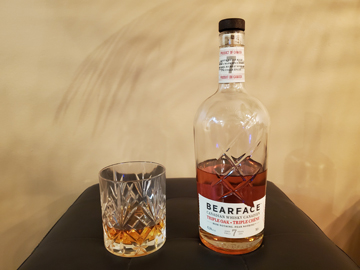
Origin: Collingwood, Canada (Ontario)
Type: canadian whiskey
Alcohol Content: 42.5%
Aged: 7 years
Notes: matured in bourbon and red wine casks
Price: 36 / 750 mL
Review Date: 2020-11-09
The only product from this label so far, it is presented in a nice bottle with claw marks on the side and intruding into the label. It is topped with a custom wood job. Top notch presentation. Unlike most Canadian whiskeys, it is aged, 7 years in bourbon barrels, and finished in French red wine and Hungarian oak for extra flavor.
Let's dig in. I've come to learn to not expect too much from the domestics, they're usually passable, but tend to be quite the blunt flavor instruments, without balance and subtlety. Starting off very sweet on the nose, almost like a fruity liqueur, with undertones of toasted oak... it's clean and tasty, so I forge ahead. The taste is a bit sweet initially, and feels nice, but then the oak completely dominates. The sweetness usually associated with oak isn't vanilla-hued, but rather comes from corn. Just as a hint of spices comes on, it's gone, leaving nothing but wood behind. Well, it is Triple Oak, so it's really unfair to criticize it on that front; it delivers what it promises. After a while, some fruit and spice develops, and something burnt, coffee-like and sharp. Overall, the intense flavors make for a nice experience, but work better for slow sipping, especially with the sweetness.
Verdict: between this and Lot 40, I am undecided yet what I'd rather have on my shelf, and Canada needs to represent.
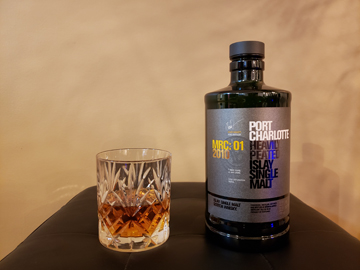
Origin: Bruichladdich, Scotland (Islay)
Type: single malt scotch
Alcohol Content: 59.2%
Aged: 7 years
Notes: matured in french oak casks
Price: 145 / 700 mL
Review Date: 2019-12-04
Starting to get on the more expensive side of "regular" scotches, available to us lowly 9-5 wage slaves, this was something of a birthday gift to myself. Comes in a fancy metal case and a very distinctive, poshly labelled and embossed bottle, that is surprisingly easy to open and pour from. It's matured specifically to pick up lots of wood, and is finished in Bordeaux casks from Chateau Mouton Rothschild, which no doubt accounts for most of the price.
Port Charlotte is an established line of scotches handled by Bruichladdich at the distllery they took over there, notable for the signature peat and "maritime" flavors. The MRC-01 continues that tradition, as you'll pick up plenty of salt/ozone on the pleasant smoke, along with the usual roster of roasted flavors such as almond, licorice, coffee and vanilla sweetness. Despite being "heavily peated", the smoke is not overpowering on the nose at all, and the scent is very fresh and lively. Expect some alcohol vapors as well, with the alcohol content clocking in at nearly 60%.
The first sip comes in very strong, with overpowering smoke quickly giving way to lots of sweetness and wine fruit, before oak and sweet nuttiness settle in. The alcohol is barely felt, except for moderate warming, and is surprisingly smooth, given both the 60% figure and a relatively short maturation period. The initial rush finishes with mild peach and spice, and lingers slightly salty and smoky, almost minty or herbal, like Jaeger. It's hard to call any scotch refreshing, especially at 60%, but this is one you can sip any time, without having to wait for a cold, stormy night, it does not feel oily or heavy. Even the color is bright and sparkling. The only caveat I can see is that a specific palate is required, because the strong smoke will clash unpleasantly with many other flavors.
Verdict: while on the one hand I question the price, on the other I really appreciate the complexity and variety of tastes and flavors I can experience, that makes me want to keep refilling the glass endlessly. And this is really trivial, but removing the stopper from the bottle feels and sounds very satisfying.
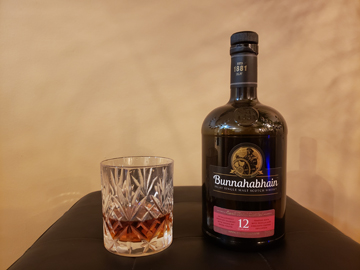
Origin: Bunnahabhain, Scotland (Islay)
Type: single malt scotch
Alcohol Content: 46.3%
Aged: 12 years
Notes: matured in sherry, bourbon and whiskey casks
Price: 91 / 750 mL
Review Date: 2019-11-19
When perusing the scotch shelf, one quickly comes to the realization it is futile to try to pronounce some of these names, without making yourself look foolish. This falls in that category.
Despite claims to "hints of seaside smoke", they are only subtle in the extreme. Perhaps I was expecting something along the lines of more smoky scotches. In fact, this scotch drinks very much like a bourbon, probably thanks to spending maturation years in bourbon casks. It's rather sweet, stopping just short of corn, with strong hints of burnt caramel, and the deep amber color to match. Alcohol content is in the higher range for liquor, it drinks smooth, the finish and aftertaste is distinctly bourbon-like, and lingers satisfyingly for many minutes, evolving into spice notes. It did not have much to offer my nose, unfortunately, except for a fresh and clean whisky smell.
Verdict: excellent for sipping owing to many flavors and layers to enjoy, good for those beginning to explore scotch and are more used to "plain" whisky. Might go well with a cigar by the fireplace to help bring out the smokiness.
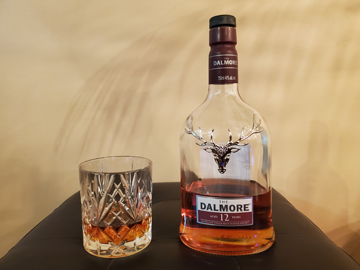
Origin: Dalmore, Scotland (Highland)
Type: single malt scotch
Alcohol Content: 40%
Aged: 12 years
Notes: matured in bourbon and sherry casks
Price: 86 / 750 mL
Review Date: 2020-12-18
Probably the most distinctive and recognizable scotch bottle in the industry, with the metallic stag's head front and centre, large and in charge. Dalmore is also a leading name in the business, with highly decorated and sought after releases. This is the 12 year, most afforable, almost surprisingly so, but in the end I think the price is well justified.
Like most Highland scotches, it's very clean and inoffensive on the nose. Spices, oak and chocolate/coffee dominate up front, slightly buttery with dried citrus. It drinks unlike almost any other scotch, it's very appropriate for the season, with flavors typically associated with a Christmas evening by the fireplace: the citrus continues into a more dense and sweet flavor, like in a Christmas cake, the chocolate carries through, and the wood disappears entirely. The finish is the disappointing part, it's indistinct and lacking complexity, but the 12 year IS the bottom entry after all. It's not bad, by any means, just leaves wanting a bit more.
Verdict: a solid scotch you won't regret picking up, especially this time of year.
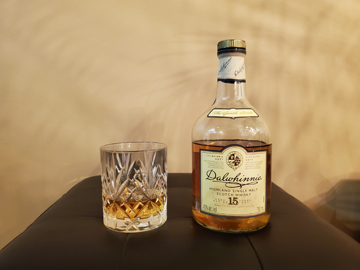
Origin: Dalwhinnie, Scotland (Highland)
Type: single malt scotch
Alcohol Content: 43%
Aged: 15 years
Notes:
Price: 100 / 750 mL
Review Date: 2021-06-16
Located between two mountain ranges, Dalwhinnie is a well-respected member of the Scotch distillery industry, if rather low profile. Technically located in Speyside, but grouped with Highlanders, it's the highest distillery in Scottland, or second highest, with a newly opened Braeval beating it by a couple meters, it has a lot going for it. The 15 year is their main product, and it comes in a squat bottle with a basic cork.
Light golden in color, you'll smell the Highland regulars: light and citrusy, with a bit of brine and sweetness. It comes in sweet and malty, with vanilla and toasted oak poking in, with a brief alcohol burn. Spices and nutmeg take over, and there is much more wood, carrying through to a nice wood and spice finish. This dissipates quickly, making for a very light drink.
Verdict: not particularly special in any way, and the price isn't justified for me. Pick it up on sale to try for some variety.
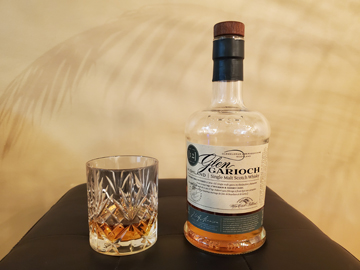
Origin: Aberdeenshire, Scotland (Highland)
Type: single malt scotch
Alcohol Content: 48%
Notes: aged in bourbon and sherry casks
Price: 62 / 750 mL
Review Date: 2020-10-07
Located on the east side of Scotland, near Aberdeen, this distillery only features two whiskeys, the 12 and the new and rough Reserve, and a variety of vintages. I've only recently started digging into the Highlands whiskeys, and so far I definitely like what I've tried. Highlands scotches tend to be more "tame" in flavor profile, more similar to Irish whiskey or bourbon, usually unpeated, and fruity and sweet.
The distillery page suggests pairing with hard, dry cheeses, such as Parmesan, and, well, for now I will take their word for it, but I will keep it in mind next time I am grocery shopping. On the nose it is honeyed and floral, a bit like a white wine, but not quite as strong as Lohin McKinnon, a local concoction. The taste is sweet, with some oak and fruit coming through, and something heavy, like banana. I would not describe it as being particularly complex, but it is very well balanced with good character, something I am coming to expect from Highlands. The sherry casks impart some nice fruitiness on the finish that lasts long between sips.
Verdict: the Highlands "shelf list" is growing rapidly, but I think this one will be a finalist.
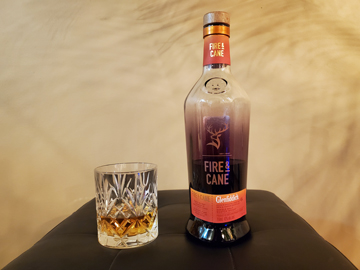
Origin: Dufftown, Scotland (Speyside)
Type: single malt scotch
Alcohol Content: 43%
Notes: finished in sweet rum casks
Price: 79 / 750 mL
Review Date: 2020-05-29
The elusive fourth entry in Glenfiddich's experimental series. I've had the pleaseure of tasting the #1, finished in ex-IPA barrels, which was quite excellent, but it was a gift bottle and so I had not had the chance to review it here yet. It is back in my personal queue.
This is quite the young whiskey, as far as I can tell, and it only spends a few months in the rum casks. Makes it seem as a bit of a gimmick, but perhaps even this short amount of time is sufficient to get the job done. The presentation is top-notch, the distinctive Glenfiddich bottle shape is beautifully gradually smoked in what appears purple or smoke-grey, I will know once it is empty.
As expected from the name and descriptions, the flavor is rum-sweet, with firey smoke. The whiskey itself is solid enough, quite smooth given the short maturation, perhaps the sweetness tempers it. Unlike the Lohin McKinnon Peated, which I found generally disagreeable, the Fire & Cane comes in rather pleasant. Yes, the sweet and smoky combination does not always pair well, depending on current palate, but it's been nice much more often than not. Another comparable, the Balvenie Caribbean Cask, lacks smoke entirely, and is a completely different beast. The smoke is well defined on the nose, without being overpowering, but hits hardest on first taste, and morphs into oak and rich caramel, with some fruit and lingering smoke, which persists along with the sweetness. As promised, it's definitely a bold mix, exploding with sweetness and gentle smoke if you hold the liquid on your tongue for a few seconds.
Verdict: an interesting experiment, and I look forward to seeing what else this team will come up with. Give this one a try, you never know how long it will remain in production.
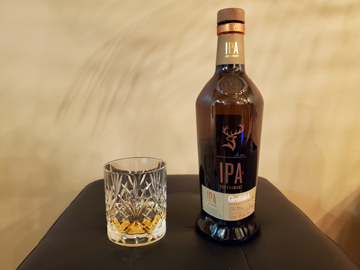
Origin: Dufftown, Scotland (Speyside)
Type: single malt scotch
Alcohol Content: 43%
Notes: finished in IPA casks
Price: 79 / 750 mL
Review Date: 2020-11-07
The first entry in the experimental series from Glenfiddich, that I've meant to review for some time since buying it as a tasting gift. Eventually, I bought a bottle for myself to spend some time with, to see how the beer-infused concoction holds up to scrutiny.
The IPA is finished for 3 months in ex-IPA barrels, which should hopefully give it some citrusy zest. It's there a little bit on the nose, with fresh apples and a touch of hops, you can tell it's something different, and more reminiscent of Highland scotches. A hit of intense sweetness pours out first, followed by fruit, almost like apple juice. Creamy vanilla pokes out, with very aromatic citrus and hops following, sticking around between sips for quite a while.
Verdict: I will enjoy tasting this once in a while, as it's quite interesting, and unless there is another batch coming out, it appears to already be selling out of stock locally.
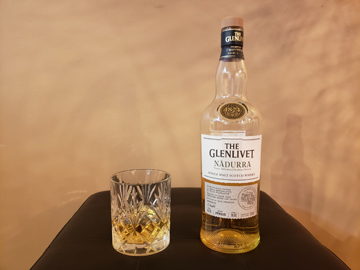
Origin: Ballindalloch, Scotland (Speyside)
Type: single malt scotch
Alcohol Content: 59.8% (cask strength, batch FF0115)
Aged: 16 years
Notes: matured in first fill american white oak casks
Price: 95 / 750 mL
Review Date: 2019-11-21
There is some background to lay out first, before diving into the Nadurra. This is bottled cask strength, which is to say it is not diluted to a specific alcohol content. As such, each batch will have a differing amount, and each batch will vary slightly in taste. Also, you may not be able to purchase this where you live at all, or it may be "nerfed" down to 48%. That's still strong, but a part of the Nadurra experience will be missing.
As far as modern scotches go, this one lives up to its name. Nadurra, meaning "natural" in Gaelic, is about craftsmanship delivering the best, simplest, and most natural scotch, stripped down to its base essence. The maturation casks are first fill American oak, they have never been used previously. Many scotches use a variety of previously used casks to impart additional flavors and add complexity into the body.
Even if you know nothing about distilling or wine-making, I am certain you will very quickly identify the unmistakable "woodsy" fresh cut oak scent coming out of the glass. Once you get past the alcohol sharpness, that is. There is also the presence of a strong vanilla sweetness. Taking a sip, there is simply no way to hide the 60% alcohol. There is a sharp bite, and warmth quickly spreads through your face. The vanilla continues, and banana and almond join in. Everything goes down surprisingly smoothly, leaving nutty vanilla goodness behind for a couple of minutes before evaporating into something vaguely like orange peel. Enough time to get ready for the next light golden sip.
Verdict: many people will want to dilute this in glass with some water or ice. Or you can drink it straight, and probably wake up with some extra hair on your chest. I recommend the later.
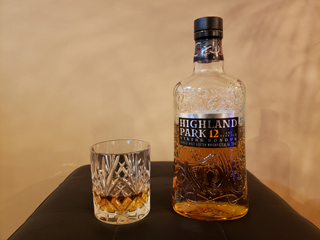
Origin: Orkney, Scotland (Islands)
Type: single malt scotch
Alcohol Content: 43%
Aged: 12 years
Price: 62 / 750 mL
Review Date: 2020-01-06
The Highland Park Distillery is the northernmost scotch distillery in the world, known for a large selection of themed and special releases. The main theme is... Vikings. Apparently, the Orkney Islands were originally colonized and occupied by various Viking settlements, or so I learned from the text printed on the very nice box this very nice bottle comes in. The 12 year carries the "viking honor" designation, and has all manner of fantastic flora, fauna and symbology all over. The stopper implements a rather interesting interlocking overlap with the opening of the bottle, something I have not seen before.
The spirit is light colored, entirely taken from the maturation barrels. The smell is very sea-breezy, intense, fruity with lots of apple, honey and salt. It is peated, but no smoke will be detected by your nose. Similar to the Jura 12 year, I get the same roundness feeling on the taste, except to an even greater extent. Whereas Jura was just hinting at it, the Highland Park is like drinking air, it feels like most of it evaporates off your tongue immediately. What can be tasted is sweet and creamy, and little bit woodsy and citrus. Only on the finish can you feel any smoke at all, it is entirely aromatic, and combines wood, spice and some malty sweetness, and sits very nicely between sips.
Verdict: this is a fantastic drinking scotch, very light and flavorful. I would like to explore more of their line up, but the price escalates quickly.
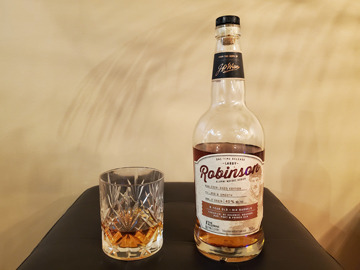
Origin: Toronto, Canada (Ontario)
Type: canadian whiskey
Alcohol Content: 40%
Notes: aged in 6 different barrels
Price: 40 / 750 mL
Review Date: 2020-11-21
Part of JP wiser's Alumni Whisky Series, a special one-time release. This is the 666: 6th (and last) in the series, aged for 6 years, in 6 different barrels.
I've been enjoying some special limited Canadian whisky releases, and they are generally quite good, but have very distinct and particular traits that take some getting used to. Larry's is spice on the nose, with plentiful lumber and anise, slightly fruity and floral. The taste is predominantly earthy, as worthy of a proper Canadian rye, although it is 2-grain, and lots of oak, as expected from the 6 barrel aging. The difference between the two inputs makes for an interesting experience. The finish is strong with apple and pear, and lasts for a while with florals, almost like a compote.
Verdict: special editions are an interesting hit and miss, but always provide good times. I'd like to try the rest of the series, if I come across any.
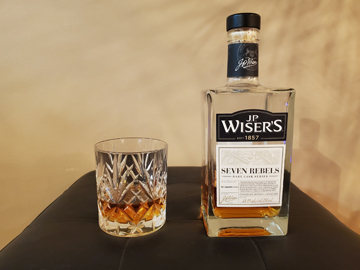
Origin: Toronto, Canada (Ontario)
Type: canadian whiskey
Alcohol Content: 42.8%
Notes: matured in oak and speyside casks
Price: 70 / 750 mL
Review Date: 2020-04-05
Packaged in nice and distinctive bottles, this is a special edition in the JP Wiser's Rare Cask Series, produced exclusively for BC Liquor stores. It is a blend of seven whiskeys, in tribute of the seven major figures in the Canadian distillery business.
Throwing pretty much everything and the kitchen sink into the bottle, we have all kinds of stuff happening. First out, there's plenty of cloves, ginger and cinamon, and some sweetness and oak to inhale. That's a lot already. The taste is very bourbon-like but without the sweetness, with cherry and oak coming through at the end, and spice and a touch of toasted oak lingering for a while. There is definitely a lot to taste here, and no doubt the flavors will change with your palate. Is there some rye poking through? Perhaps, that's too much for me to decypher, but it is a fantastic drink to dig into and savor the complexity.
Verdict: I don't know if this is a limited series bottling, but I think I will be buying a small stash for myself.

Origin: Craighouse, Scotland (Islands)
Type: single malt scotch
Alcohol Content: 40%
Aged: 12 years
Notes: matured in bourbon and sherry casks
Price: 76 / 750 mL
Review Date: 2019-11-24
This amber scotch is from the island region, Isle of Jura specifically, a region that does not see much representation, with Talisker being perhaps the most well known brand. Recently, the distillery has undergone something of a re-invention, with bolder, more distinct spirits to carve out a place for itself, leading the way visually with a unique bottle design.
The first time I tried it, I was not a big fan. You're greeted with a medley of scents, fruit (plum?), vanilla, sweetness, some oak, a promise of smokiness, and an undercurrent of... sour? But, the nature of smell is such that it saturates quickly, and then it becomes chocolatey and indistinct.
Tasting it, the source of the sourness is apparent: the predominant flavor is slightly salted banana. Although on the initial tastings this was my big problem with this scotch, as it felt very overwhelming in combination with a feeling of oiliness, especially on the finish, but over time I've become accustomed to it. You can tell by the level in the bottle I have really dug into it. The thickness and oiliness is visible on the glass after giving it a good swirl, this is something one would expect from an Islay scotch, and Jura is a stone's throw away after all. You hear how maturing sea-side will pick up the saltiness in the air, and while I do absolutely think various environmental factors affect the final taste, this one may be a bit of a romanticizing stretch. Other than that, look for sweetness, light smokiness, and overall smooth and light experience. The smoke will persist for a few minutes, as will the bit of plum-like fruitiness.
Verdict: it is light, and easy-drinking, and I appreciate the touch of smoke which many people see as a signature of scotches. I would recommend you give this a try if the opportunity to sample presents itself, before buying the bottle.

Origin: Clermont, US (Kentucky)
Type: kentucky straight bourbon
Alcohol Content: 50%
Price: 47 / 750 mL
Review Date: 2019-12-19
Like most large-volume American whiskeys, there is not much information available about the making process, besides the location of the distillery, Kentucky in this case. Knob Creek is a well respected rye producer, with a couple bourbon selections. Like other bourbons, they probably utilize new oak barrels, charred and toasted, with relatively short maturation period. Whiskey, and bourbon especially, tend to be on the more rough side, not as smooth and refined as scotch or Irish whiskey.
The flat, prohibition-style bottle is neat, with a retro, hand-made looking label slapped on and a goop of plasticy wax sealing the works, an increasing trend that I personally do not appreciate. However, the quaint "small batch" theme is betrayed by a cheap rubber cork, that is fiendishly difficult to remove, so I just leave it half-inserted.
On the nose, the Knob Creek is typical of modern bourbons, with lots of fresh cut oak, and a distinct herbal/medicinal smell, that I like to call "jasper". Other than that, we've got lots of burnt sugar, as to be expected from a bourbon. Sweet caramel and hardly any corn dominate the flavor, then settle into a pleasant herbal medley of spice, licorice and maybe cloves, with the oak always hanging around in the background. The 50% alcohol makes itself known throughout, which is why you pick a bourbon over anything else in the first place.
Verdict: I've come to learn there are two types of bourbon: sweet and corny, and oaky and herbal. From the herbal side, I like the Knob Creek so far, better than Elijah Craig, although that presentation is hard to beat.
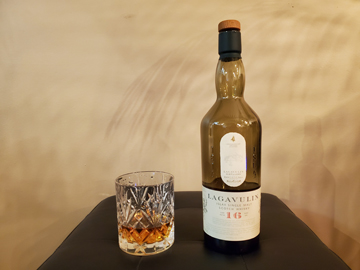
Origin: Lagavulin, Scotland (Islay)
Type: single malt scotch
Alcohol Content: 43%
Aged: 16 years
Notes: matured in oak casks
Price: 140 / 750 mL
Review Date: 2020-11-06
Lagavulin is the flagship of Islay, and the 16 Year is the flagship of Lagavulin. Located on the south coast of Islay, between Laphroig and Ardberg, you already know what to expect from it as the reputation of the region precedes it.
This was one of my first scotch purchases and I've been enjoying it for some time, but never got around to reviewing it. As expected, it's full of smoke, right out of the bottle. It this regard, it's less raw and intense than Laphroaig, if you're already familiar with it. However, doubling the maturation period does come with some sophistication, that that's reflected throughout. There is more complexity and subtle notes on the nose, adding spices and vanilla. In the mouth, it's thick and rich with smoke and oak, with fruity and malty sweetness coming out as those fade quickly. The sweetness is moderate as well, overall it's not a wild and crazy ride, but rather smooth and easy to enjoy. The finish is long, with flavors of dense dried fruits like dates and figs, and just a hint of smoke and vanilla.
Verdict: it is pricey, but should have a spot of honor on any scotch drinker's shelf.
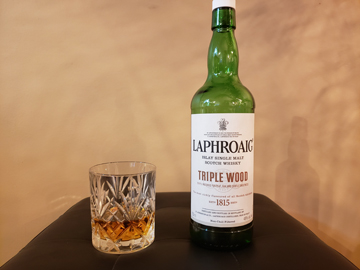
Origin: Laphroaig, Scotland (Islay)
Type: single malt scotch
Alcohol Content: 48%
Notes: triple matured in bourbon and sherry casks, and custom casks
Price: 90 / 750 mL
Review Date: 2019-11-25
This was my first foray into the shadowy world of smoky scotches, and I went in neck deep. During the process of drying the mash, burning peat is introduced, and it imparts the distinct smoky flavor to it, which then transfers through distillation and into the bottle. It is common among Islay region distilleries. Laphroaig is apparently known for particularly heavy smokiness, and the Triple Wood is actually a more matured and smoother version of the Quarter Cask.
As soon as you remove the cork and start pouring, you unleash it. The smoke. The entire experience can be described as sitting on a stormy ocean beach, wind whipping sea spray in your face, so you shove your face into the campfire and get a lungful of smoke. Upon closer inspection, the smoke has a tinge of BBQ or smoked meats. Besides the smoke, there is salty sweetness, banana and apple. There's a hint of molasses that suggests this will not be a light drink. It works for me, as I do enjoy sticking my nose into the glass before a sip and taking everything in.
Peat smoke is the first and foremost flavor you will taste, and it never goes away but it does reduce in intensity quickly. It goes down smooth, and feels very mealy and full, with an aftertaste of salty caramel and oiliness, if it is possible to taste such a thing. Liquid sticks to the sides of the glass, and recedes slowly, leaving droplets behind. If you let the scotch sit on your tongue for a bit, intense sweetness of dried fruit, caramel and anise, along with smoke, make their way through the palate into the nose, and I had a brief "spoonful of wasabi" moment on my very first sip. One needs to treat the Triple Wood with respect.
All things seriously, this scotch comes with lots of flavors and sweetness, and it is not harsh at all, even with the relatively high alcohol content. The more you drink it, the more different flavors evolve. I can't find any information about how long they're keeping this in wood, but it's long enough to round off all the edges, probably 12 to 16 years.
Verdict: not the absolute smokiest out there, but should prove lots of fun for the adventurous. Or save yourself some money and try the campfire.

Origin: Surrey, Canada (BC)
Type: single malt whiskey
Alcohol Content: 43%
Notes: matured in oak barrels
Price: 60 / 750 mL
Review Date: 2020-02-28
A local find from the Central City Distillery located in Surrey BC, better known to most people as Central City Brewery. Like the brews, it is made with Canadian ingredients; barley and water, distilling since 2013. No specifics are given regarding maturation time or type of barrels used, but the typical ex-bourbon and probablly assorted wine casks can be safely assumed.
The very light gold spirit comes in a classic shaped bottle, topped with a tidy wood and cork stopper. The aroma is quite light, with lots of apple, some vanilla and just a touch of oak. It promises a tasty and smooth drink, in contrast to the majority of Canadian liquors I have tasted to date, which tend to be made from rye and end up on the rougher side. The flavor explodes with even more apple and grapes, buttery and slightly woody, very soft and smooth, with some mash coming through. The finish begins oaky, later overtaken by grape, and lingers for a long time, much like a fruity white wine like a riesling or gewurtz.
Verdict: a surprising find, this is a fine Canadian whiskey, and I am excited to sample the peated variety in the future.

Origin: Surrey, Canada (BC)
Type: single malt whiskey
Alcohol Content: 43%
Notes: matured in oak barrels
Price: 60 / 750 mL
Review Date: 2020-03-18
Here is the peated version of the previously reviewed single malt. This will be a very short review, because this smoky whiskey falls quite a bit short. Not just against other peated scotches, but also vs the regular unpeated one. It is basically the same, but with smoke added. I'd be very curious to know whether it is actually peated, or utilizing something like liquid smoke. Simply put, it just doesn't go very well with the base flavor of the whisky. It's a little on the sweet and fruity side, which clashes with smoke. I noticed previously that drinking peated scotch after/with certain foods just didn't work. This is the case here. It is rather lightly smoky, and not particularly strong on the nose.
Verdict: it's not hard to get through, but will not be a repeat purchase.
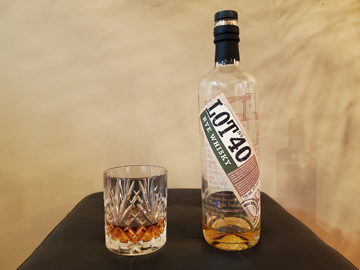
Origin: Windsor, Canada (Ontario)
Type: rye whiskey
Alcohol Content: 43%
Notes: matured in virgin oak barrels
Price: 38 / 750 mL
Review Date: 2020-03-14
Lot 40 is a smaller Canadian distillery owned by Corby, who own other brands such as JP Wisers, Aberlour, Jameson, Glenlivet, Redbrest, etc, and is part of the Northern Border Collection, producing rye-based whiskeys. As you can see from my accompanying picture for this entry, I have gone through nearly the entire bottle, which is what it took to get to the point where I feel I can review it. Every liquor has its own character and way of drinking and tasting, that you have to get into and used to, before pronouncing judgement, in my opinion. I will get there eventually with tequila, but I wanted to get to rye first, because it is quintessentially Canadian, so it is perhaps surprising I did not get around to it yet. Probably because it has a lower profile, and is less glamorous than more expensive imported spirits.
At first, and for a long time, I really did not like this. From the smell, which reminded me of cheap moonshine and soggy bread, to the taste, which was more earthy and malty than I was used to, to the aftertaste, indistinct and inappropriate for a whiskey. However, after nearly a whole bottle, and paying attention to the tastes and flavors, I have somewhat come around.
You can smell the difference right away, compared to other whiskeys. The rye kicks in immediately, with caramely, dried sugary fruit, like orange, fig and raisins. The rye and alcohol definitely overpowers everything, but I think I detect some hints of oak as well. There is more oak on the tongue and finish, but generally you get sweet notes of vanilla and burnt sugar, with some floral and spice highlights mixed in. Spice and rye lingers between sips.
Verdict: I have not yet had enough rye tasting to rank this anywhere, but I am generally happy with Lot 40 for now.
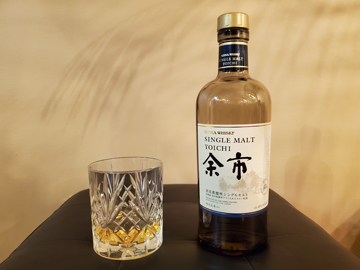
Origin: Yoichi, Japan (Hokkaido)
Type: single malt whiskey
Alcohol Content: 45%
Notes: variously aged, matured in sherry casks
Price: 95 / 700 mL
Review Date: 2011-11-17
There are quite a few Japanese whiskey distilleries, and this one turns out scotch-inspired spirits, and has quite the selection as well. Japanese whiskey apparently tend to come with screw caps, not corks, which gives the works a unique twist, as it were.
Through and through, the best I can describe the experience is quintessentially Japanese: elegant and balanced, as all things should be. But far from simplified. Right from the bottle, there is light peat, sweet citrus, spices, and floral notes. Complex and full, but with no single dimension overpowering. The peat and smoke hits first, then spices and nuts emerge, and smoke finally takes over to carry things between sips. The finish is lasting and smooth, as complex as anything else. Salty, with lots of spice and malty earthiness. The longer you taste it, the more you discover.
Verdict: this is a solid whiskey, but the price is a little steep for something not quite exceptional, especially since it's also not the "full" 750mL.
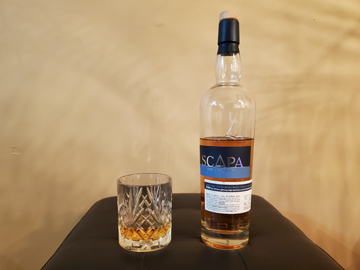
Origin: Kirkwall, Scotland (Islands)
Type: single malt scotch
Alcohol Content: 40%
Aged: 10
Notes: matured in american oak casks (batch SK17)
Price: 74 / 750 mL
Review Date: 2021-11-16
The Orkneys are lumped with the Islands region, but the two distilleries there produce a very clean and crisp whiskey that's more characteristic of Highlands and rarely peated, and are sometimes put in their own separate scotch-producing region.
The non-traditional bottle shape indicates you're in for something different, a cross between scotch and American whiskey maybe. Very Highlands on the nose, with crisp apples, toffee, and hint of brine. The flavor is full of sweetness, some bready fullness, almost like rye, sweet spice and more apple. The finish is soft, due to the low alcohol content probably, but lingers nicely, leaving more apples and brown sugar.
Verdict: a nice find, and at a good price, might become a recurring purchase.
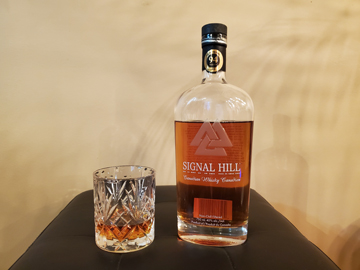
Origin: St John's, Canada (Newfoundland)
Type: canadian whisky
Alcohol Content: 40%
Notes: matured in white oak and bourbon casks
Price: 40 / 750 mL
Review Date: 2021-02-03
I've been digging into Canadian whiskys recently, and this is a very recent acquisition; I'm reviewing it quite quickly compared to others. An independent production, presented in a classy bottle with an embossed frosted logo to represent Norse influences, and features morse code translation to symbolize the first Marconi radio transmission which took place at Signal Hill. The stopper is a very hard to work one-piece rubbery black plastic. Unique, but somewhat disappointing of a detail.
The whisky is aged in a variety of climates and barrels to produce the specific profile. It is quite rich in flavors, but unlike some other Canadian whiskys that seem to just try too hard, it's not garish and overpowering. Not a rye, it's a blend of corn and barley distillates. It starts exactly as you'd expect from the description: a blend of bourbon and scotch, very clean and balanced, with light oak and vanilla. It feels full in the mouth, and tastes pretty much as it smells, leading with the sweetness, moving through dried fruit, like plums, and finishing with some light oak. It's round and creamy, and the finish is long lasting and warming.
Verdict: In case you can't tell yet, I'm a big fan of this, partly why I rushed to review so quickly. This is a very easy drinking whisky, not too complex, not too harsh. The price puts it in the premium Canadian whisky category, so it's not great value, but I won't nickle and dime my taste buds.
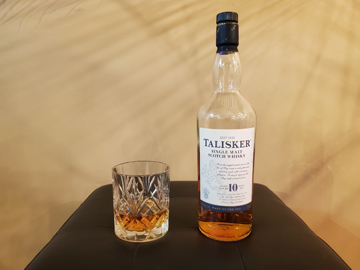
Origin: Talisker, Scotland (Islands)
Type: single malt scotch
Alcohol Content: 45.8%
Aged: 10
Notes: matured in american oak casks
Price: 100 / 750 mL
Review Date: 2020-07-26
Talisker is one of those scotches you will invariably find on a hotel bar shelf, it is something you can always count on, and that's due to the number of awards it has won. I had always assumed it was a Highlands drink, which tends to contain the more mainstream distillers. But it is from the Islands, Isle of Skye specifically. Like other high-profile scotches, it runs a bit pricey, this 10 year is among the cheapest ones.
The bottle is the classic shape, and holds this golden spirit, topped disappointingly with cheap plastic. It's petty, but probably a sign of cost-cutting. Lots of smoke on the nose, a bit salty, like smoked fish. It's light, with some fruit coming through. While smoke is pretty much all you smell, it doesn't have as strong a presence on the taste. In fact, another reason I assumed this was a Highlands scotch is that it's very balanced and well-behaved, with a clean whiskey profile. Isle and Islands scotches tend to be much more bold, flavorful and unruly, and smoke and brine is definitely part of that. Here, the smoke is balanced out by some fruity sweetness and a bit of pepper. Delicate sweetness and oak round out the experience between sips.
Verdict: definitely a solid choice, I can see why restaurants stock it.

Origin: Scotland (Speyside)
Type: blended malt scotch
Alcohol Content: 46%
Notes: matured in bourbon casks
Price: 70 / 375 mL
Review Date: 2019-12-04
Not sure what exactly to make of this scotch, as far as I can make out it's a guest blend released by the Victoria Caledonian, consisting of spirits produced by Benrinnes and Glenlossie Speyside region distilleries, to mark the occasion of the 2019 Victoria Highland Games. It is separate and distinct from the regular B&G blend they bottle, so it probably originated to sell in visitor centres and gift shops during the event, and my liquor store picked up a case of whatever was left over. The small bottle and cheesy label would tend to confirm my suspicions.
Regardless, this is a perfectly serviceable scotch, very light and fruity on the nose, apple cider and light salted caramel sweetness. The taste is strong on bourbon, resolving into intense sweet fruit and hints of red wine. The alcohol bite is quite prominent, but it is smooth and easy to drink. It is rather generic, which I expect, seeing as this is a gift bottle, with the brine and oak typically associated with scotch sticking around pleasantly between sips.
Verdict: I doubt I will be finding this bottle ever again, and would not buy it if I did, given the price and lack of any special or unique character.
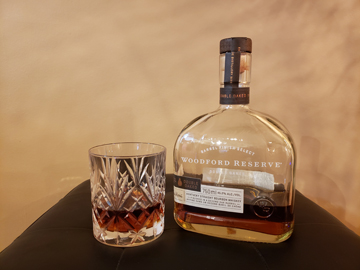
Origin: Versailles, US (Kentucky)
Type: kentucky straight bourbon
Alcohol Content: 45.2%
Notes: finished in heavily toasted oak barrels
Price: 70 / 750 mL
Review Date: 2019-11-29
There is not much information to be found in public sources about the maturation process, except that the whiskey is put into charred barrels and finished in toasted oak. This all takes place in, presumably, Kentucky, and although the requirements for calling your whiskey a bourbon, even a Kentucky bourbon, have been considerably loosened recently, I place some trust in the Woodford Reserve name. This is one of the first bourbons I have tried out in my search for a "my" bourbon, and just randomly stumbled on it. It has immediately become my favorite, and is yet to be unseated. I also tried the Distillers Select variety, and while it's a solid choice, I prefer this one by far.
Mostly, I picked up this bottle for its deep amber color, which I assumed would be very flavorful and have lots of character. I was not disappointed. I really enjoy just smelling this in the glass, sometimes even without taking a sip. It's an experience onto itself, with lots of oak, almond and butterscotch coming through, with swirls of corny sweetness. Corn mash is what separates bourbon from whiskey after all, and Woodford Reserve is generous with it. Everything combines to draw out a smell a bit like red wine, that gives it that cognac character.
The first taste is one of intense sweetness with very heavy corn top note, which quickly morphs into a rich caramel and vanilla toastiness. It's fairly smooth, but maintains enough roughness and bite to let you know there's plenty of alcohol in there. The heat and a creamy honey feeling remains for some time between sips, giving you lots to think about, something I really appreciate about multi-casked whiskeys.
Verdict: a little bit on the spendy side for an American whiskey, but it delivers such a rich experience with lots of things to taste and smell all the time, that it's definitely worth it. The Double Oaked will always have a spot on my shelf.